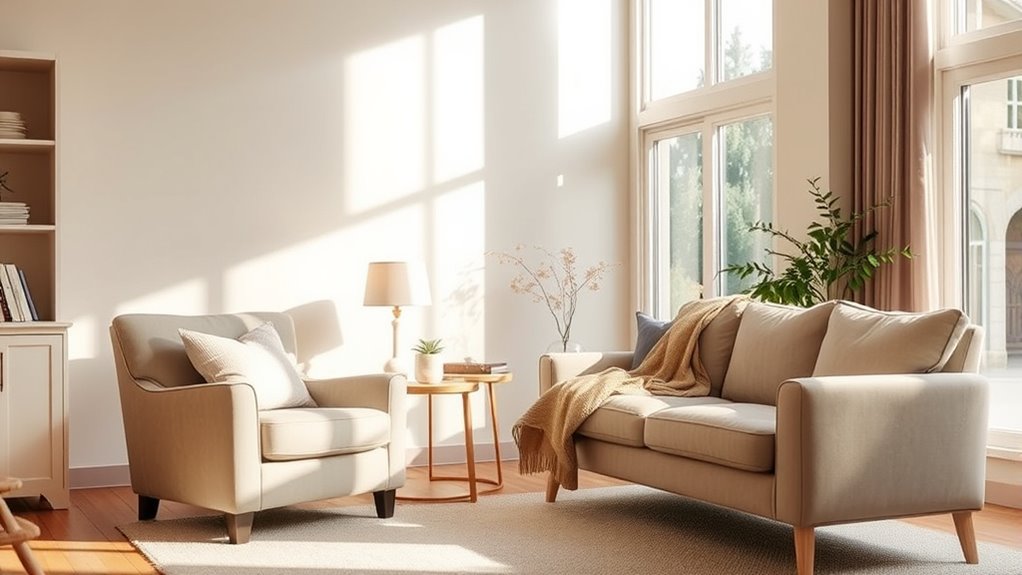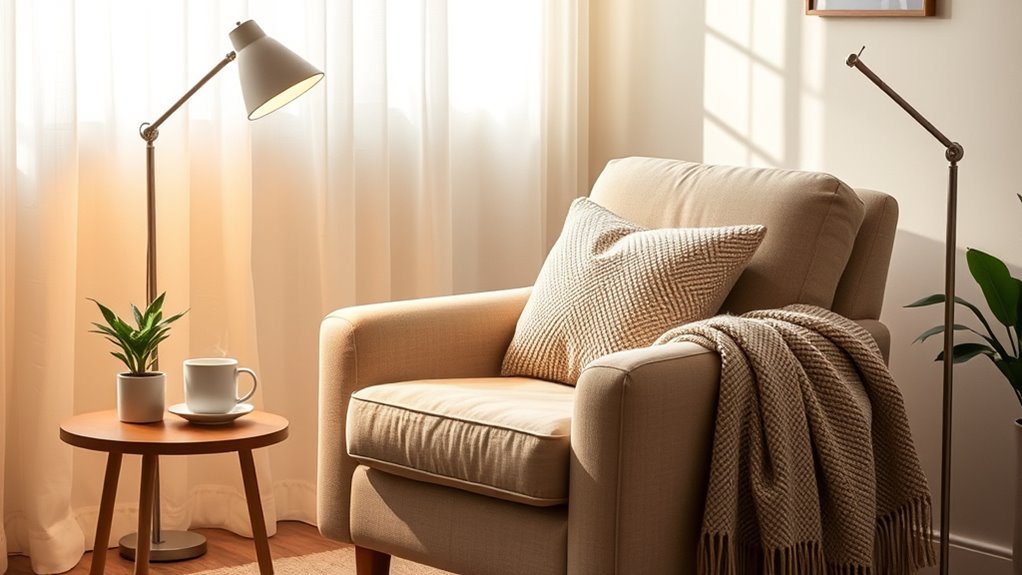To create a comfort-first palliative care space at home that’s affordable, choose a quiet, well-lit spot near windows and keep it clutter-free. Invest in an easy-to-use chair or recliner and add soft cushions or favorite blankets for comfort. Personalize the space with photos or familiar objects, and include safety features like grab bars. Keep essentials organized and maintain a calming atmosphere with gentle scents or soft background sounds. If you keep exploring, you’ll discover more ways to make this space both restful and practical.
Key Takeaways
- Choose a quiet, well-lit space near windows for natural light and calming atmosphere.
- Use affordable, comfortable furniture like recliners and add soft cushions for support.
- Incorporate personal items and familiar objects to foster emotional comfort and normalcy.
- Install safety features such as grab bars and non-slip mats to prevent falls.
- Organize supplies with baskets and shelves to keep essentials accessible and environment clutter-free.

Have you ever wondered how to create a comforting and functional space for palliative care at home? It’s a question many caregivers and family members ask, especially when you want to provide the best quality of life for your loved one without breaking the bank. The key lies in designing a space that feels safe, calming, and practical. You don’t need fancy furniture or costly renovations—simple, thoughtful adjustments can make a big difference. The goal is to make the environment feel like a sanctuary, where your loved one can relax, receive care easily, and feel at peace.
Start by choosing a quiet, well-lit area in your home. Natural light can boost mood and create a warm atmosphere, so pick a spot near windows if possible. Keep the space clutter-free; organization is essential for safety and ease of movement. Use storage solutions like baskets or shelves to keep medical supplies, blankets, and personal items within reach but out of sight when not in use. Comfort matters most, so invest in a good-quality chair or recliner that’s easy to get in and out of, and add soft cushions or throws to make it inviting. If your loved one spends a lot of time in bed, ensure the bed is comfortable, with adjustable features if possible, to assist with repositioning and reduce discomfort.
Choose a quiet, well-lit space with comfortable furniture and organized essentials for a soothing palliative care environment.
Creating a calming environment can be as simple as adding personal touches—photos, favorite artwork, or comforting objects that remind your loved one of happy memories. Keep familiar items nearby, like a favorite blanket or book, to foster a sense of normalcy. To support their needs, consider installing grab bars or non-slip mats in the bathroom, which can enhance safety without requiring costly modifications. Make sure the space is easy to access from other parts of the house, especially if mobility becomes limited. Clear pathways prevent falls and make it easier for caregivers to move around.
Additionally, incorporating elements from vetted Halloween product reviews, such as themed decorations or comforting accessories, can add a touch of cheer and distraction during challenging times. Lastly, think about sound and scent. Soft background music or nature sounds can promote relaxation, while gentle, soothing scents like lavender or vanilla can help ease anxiety. Maintaining a clean and fresh environment is crucial, so regular cleaning and good ventilation are essential. Remember, creating a comfort-first palliative care space isn’t about spending a lot—it’s about thoughtful choices that prioritize safety, familiarity, and peace. With some planning and care, you can transform a corner of your home into a nurturing retreat that truly supports your loved one’s well-being.
Frequently Asked Questions
How Can I Personalize a Palliative Care Space on a Budget?
You can personalize a palliative care space on a budget by adding meaningful items like favorite photos, comforting blankets, and personal mementos. Use cozy, affordable furniture and incorporate calming colors that suit your loved one’s preferences. Repurpose existing items or craft DIY decorations to save costs. Focus on creating a warm, familiar environment that feels safe and comforting, making it truly personalized without overspending.
What Are Essential Safety Features for Home Palliative Care Areas?
You should include non-slip rugs or mats to prevent falls, install grab bars in bathrooms, and guarantee clear pathways free of clutter. Use nightlights to improve visibility at night, secure furniture to walls, and keep emergency contact numbers easily accessible. Regularly check electrical cords and appliances for damage, and consider a medical alert system if needed. These safety features help protect your loved one while maintaining a comfortable environment.
How Do I Involve Family Members in Designing the Space?
You involve family members by discussing their needs and preferences early in the design process. Encourage open communication, ask for their input on layout, furniture, and safety features, and consider their daily routines. You can also create a collaborative plan, making sure everyone feels heard and involved. This approach helps foster a supportive environment, ensuring the space truly meets the needs of both the patient and their loved ones.
What Are the Best Low-Cost Materials for Comfort and Durability?
A stitch in time saves nine, so choosing cost-effective, durable materials is key. Opt for foam padding covered with washable, breathable fabric like cotton or polyester blends for comfort. Use plywood or MDF for furniture, painted with non-toxic, easy-to-clean finishes. Layer in soft rugs, throw pillows, and blankets made from affordable, durable fabrics. These materials balance comfort and longevity without breaking the bank, ensuring your space is welcoming and resilient.
How Can Technology Enhance Comfort in Home Palliative Care Spaces?
Technology can considerably boost comfort in your home palliative care space by integrating smart lighting, adjustable beds, and climate control. You can use voice-activated devices to easily manage settings without hassle, ensuring your loved one stays comfortable. Additionally, monitoring systems provide real-time health updates, allowing prompt responses. By incorporating these tools, you create a more soothing, responsive environment that adapts to needs and enhances overall well-being effortlessly.
Conclusion
Creating a comfortable palliative care space at home is more affordable than you might think, and it can make a meaningful difference for your loved ones. Did you know that 70% of patients feel more at ease when they have a dedicated, comforting space? By prioritizing comfort and simple design, you can provide peace and dignity without breaking the bank. Start small, focus on what matters most, and turn your home into a supportive sanctuary.









